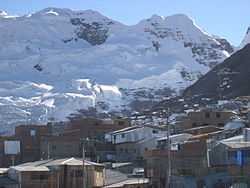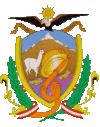La Rinconada, Peru
| La Rinconada | |||
|---|---|---|---|
|
View of the city | |||
| |||
 La Rinconada | |||
| Coordinates: 14°37′57″S 69°26′45″W / 14.63250°S 69.44583°WCoordinates: 14°37′57″S 69°26′45″W / 14.63250°S 69.44583°W | |||
| Country |
| ||
| Region | Puno | ||
| Province | San Antonio de Putina | ||
| District | Ananea | ||
| Elevation | 5,100 m (16,700 ft) | ||
| Population (2012) | |||
| • Total | 50,000 | ||
La Rinconada is a city in the Peruvian Andes located near a gold mine.[1] It is the highest elevation human habitation in the world.[2][3]
Geography
The city is located in the Ananea District, San Antonio de Putina Province. It lies at a height of 5,100 m (16,732.28 feet) above sea level. It sits at the foot of La Bella Durmiente, "The Sleeping Beauty" glacier. Miners who live in La Rinconada while working often have homes in Juliaca which has municipal services and is at a lower altitude.[4]
Climate
Located in the Andes, La Rinconada has an alpine climate (ET, according to the Köppen climate classification). The city has humid summers, dry winters and chilly to cold temperatures throughout the year, with snowfalls.
The average annual temperature in La Rinconada is 1.2 °C and the average annual rainfall is 707 mm.
| Climate data for La Rinconada | |||||||||||||
|---|---|---|---|---|---|---|---|---|---|---|---|---|---|
| Month | Jan | Feb | Mar | Apr | May | Jun | Jul | Aug | Sep | Oct | Nov | Dec | Year |
| Average high °C (°F) | 8.3 (46.9) |
7.7 (45.9) |
8.0 (46.4) |
8.6 (47.5) |
8.5 (47.3) |
8.2 (46.8) |
8.2 (46.8) |
9.6 (49.3) |
9.6 (49.3) |
11.0 (51.8) |
10.3 (50.5) |
8.7 (47.7) |
8.89 (48.02) |
| Daily mean °C (°F) | 2.6 (36.7) |
2.5 (36.5) |
2.4 (36.3) |
1.7 (35.1) |
0.5 (32.9) |
−1.7 (28.9) |
−1.5 (29.3) |
−0.4 (31.3) |
1.3 (34.3) |
2.5 (36.5) |
2.4 (36.3) |
2.7 (36.9) |
1.25 (34.25) |
| Average low °C (°F) | −3.1 (26.4) |
−2.6 (27.3) |
−3.2 (26.2) |
−5.1 (22.8) |
−7.5 (18.5) |
−11.6 (11.1) |
−11.2 (11.8) |
−10.3 (13.5) |
−7.0 (19.4) |
−5.9 (21.4) |
−5.5 (22.1) |
−3.3 (26.1) |
−6.36 (20.55) |
| Average precipitation mm (inches) | 135 (5.31) |
113 (4.45) |
106 (4.17) |
50 (1.97) |
19 (0.75) |
7 (0.28) |
6 (0.24) |
15 (0.59) |
34 (1.34) |
51 (2.01) |
67 (2.64) |
104 (4.09) |
707 (27.84) |
| Source: Climate-data.org[5] | |||||||||||||
Population
From the year 2001 to 2009, the population grew to 30,000 inhabitants from just a small prospector camp, as the price of gold rose 235% in the same time.[6]
Economy and infrastructure
The economy is mainly based on the production of gold from nearby gold mines, many artisanal.[4]
Many miners work at the gold mine owned by Corporación Ananea. Under the cachorreo system they work for 30 days without payment. On the 31st day they are allowed to take with them as much ore as they can carry on their shoulders.[6] Whether the ore contains any gold or not is a matter of luck. Pocketing of nuggets or promising chunks of rich ore is tolerated. Women are banned from the mines, but pallaqueras can be seen working though rock on the mine dumps.[4]
Environmental problems
The city has no plumbing and no sanitation system.[6] Besides having no sewage system there is significant contamination with mercury due to the mining practices. Local miners refine the ore by grinding and treating it with mercury and pressing the mass through a cloth to filter it. The resulting amalgam is heated to remove the mercury.
See also
- List of highest cities in the world
- Gorakshep - a base camp in Nepal at 5,164 m (16,942 ft), near Mount Everest.
References
- ↑ Altitude of Human Survivability, Maximum (Vertical Limit).
- ↑ http://online.liebertpub.com/doi/abs/10.1089/15270290260512882
- ↑ http://www.washingtonpost.com/lifestyle/travel/in-la-rinconada-peru-searching-for-beauty-in-ugliness/2013/02/28/aa0dc6b2-7ad9-11e2-82e8-61a46c2cde3d_story.html
- ↑ 4.0 4.1 4.2 William Finnegan (April 20, 2015). "Tears of the Sun The gold rush at the top of the world." (The New Yorker). Retrieved April 13, 2015.
Many mining towns are company towns. La Rinconada is the opposite. Nearly all the mines and miners here are “informal,” a term that critics consider a euphemism for illegal. Ilasaca prefers “artisanal.” The mines, whatever you call them, are small, numerous, unregulated, and, as a rule, grossly unsafe. Most don’t pay salaries, let alone benefits, but run on an ancient labor system called cachorreo. This system is usually described as thirty days of unpaid work followed by a single frantic day in which workers get to keep whatever gold they can haul out for themselves.
- ↑ "Climate: La Rinconada, Puno". Retrieved 2 November 2014.
- ↑ 6.0 6.1 6.2 National Geographic Magazine, January 2009
External links
 Media related to La Rinconada, Puno at Wikimedia Commons
Media related to La Rinconada, Puno at Wikimedia Commons La Rinconada travel guide from Wikivoyage
La Rinconada travel guide from Wikivoyage- Documentary film shown on www.dev.tv


